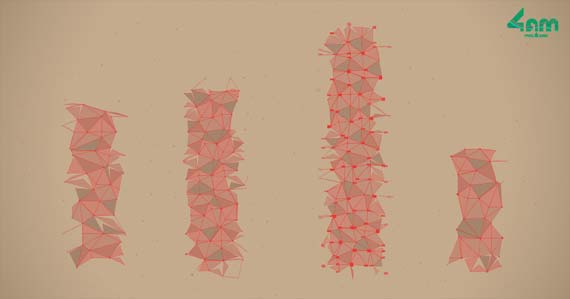
Though very nearly missing the boat on the latest release from Q-Games, I’ve finally stolen time with the title in recent days, which has proved a curious and intimidating affair.
Setting aside the presence of a very helpful tutorial for a moment, there’s a point at which the player begins their first performance, where music tracks begin to play and the trippy visualizer takes over the television screen, and the terrifying realization that one must find a way to create can feel a bit paralyzing and confusing.
Not unlike a frightened animal, I began flailing my limbs, which armed with a PlayStation Move controller exposed the interactive potential to manipulate the audio. Initially, the experience is similar to prehistoric man striking at objects with a leftover dinner bone to find a marvelous world of sounds all around. As a modern man, armed with said Move controller, I was no less perplexed and fascinated by the possibilities – the great discovery of the potential to create coupled with the terrible burden of making some sense of the opportunity, emerging from the cave with fresh experience for the trouble.
While I’m fashionably late to the party, PixelJunk 4am has picked up a bit of a reputation for being a terribly difficult game to review – fair enough given that there is no scoring system or end goal in the traditional sense. But the actual playing of 4am isn’t nearly so hard to nail down, so maybe that’s a good place to start.

4am isn’t a music creation tool, but more of a music manipulation deviation, with audio tracks waiting for players to literally reach out and touch them in order to bring strange new life to each performance, creating something unique to each set of hands that accept the challenge.
The four action buttons of the Move controller change the color of the bulb, with each color possessed of four tracks. These four tracks are tucked away in the four outer corners of the 3D canvas – the space between you and your television.
When you reach toward one of these corners, the Move controller vibrates like an excited puppy, and holding the T-button allows these tracks to be dragged into the center of the screen in order to be added to the performance – releasing the button slowly even causes the track to fade in. The immediate realization is that there are sixteen tracks in a song that can be swapped around any way you fancy.
Players can add effects to the performance by holding down the Move button and moving the controller from side to side or up and down, or even toward the screen, creating distortions and reverbs. You can even create one time quick beats by moving the controller left to right or up and down without pressing anything at all.
As previously mentioned, there’s a very helpful tutorial that goes over all these abilities from the beginning, possibly begging for some note taking, but ultimately requiring one to just jump into a performance to begin horsing around with the possibilities.
Because you’re manipulating created music, it seems impossible to create something that sounds terrible – though I feel I may have come close at times while poking around. The interesting bit of this is that it’s easy to believe that you’re doing everything on purpose when you might have no idea how you’ve done anything at all.
I’ve spent a fair amount of time just searching out sounds, and found that people have actually tuned in to watch the performance via the live viewer and even given a kudos or two. Ratings provide the most tangible sense of traditional purpose for longevity here, though it’s a bit like finding some new way to excite your lover and being pleased at the turn of events, but also a little put out that you have no idea how you did it.
Actually it’s a lot like that.

As I fell further down the rabbit hole, it became harder to dismiss moments of creation as just manipulation. 4am wasn’t long for giving me a breakdown on the potential to loop the effects I was creating by flailing my arms with some purpose, allowing me to create recurring patterns from one-off beats and distortions, and then adding even more while those looped – or clearing them and starting from scratch, or changing the song to another available within the performance. While I maintain that the initial experience is intimidating, the game does a rather fine job of layering the possibilities as one invests more time.
With the live viewer offering the opportunity to gain an audience during a performance, 4am also brings social media into the mix, allowing players to directly use Twitter and Facebook in order to act as their own publicity agent within the game. That probably isn’t surprising, but it did leave me wondering if 4am couldn’t do with a more bizarre way to act as a viral nuisance across social spheres.
The live viewer also became a primary fixation, something I’ve found quite a bit of Zen with as I can let other people’s performances play in the background to have live creation and experimentation going on at all hours of the day and night. There’s something to this aspect of 4am that left me wondering how many other gaming performances I might watch if given the opportunity.
It’s certainly the type of unique flavor Q-Games typically brings to the PlayStation Network, and in the absence of traditional goals for the pursuit of a more experimental and exploratory experience, probably is a complete pain in the ass to squeeze into the traditional review machinery. But I think it’s important to keep in mind that 4am gives back what each player is willing to invest into it, which seems true of any gaming experience, and therein helps it fit the old gears a bit easier than some have suggested elsewhere.
Perhaps the tricky bit is in nailing down a target audience to recommend the game to. While the idea of playing with visualized audio tracks would seem to make musicians a no-brainer, the lack of more precise control and structure does not. Beyond that, I’m left suggesting that anyone who wants to pick up their Move controller and capture a purer sense of play – of discovery and exploration – won’t want to let this experiment pass them by. The end goal agenda of 4am is in simply offering players the opportunity to discover and create sensations that feel good for them, and if that isn’t worth some investigation on our part as players, I don’t know what is.
Q-Games
Publisher
Sony Computer Entertainment
System
PlayStation 3 (PlayStation Network)
Modes
Singleplayer, Co-op
Release Date
May 15, 2012
Price
$9.99
*A copy of this title was provided by the publisher for review
